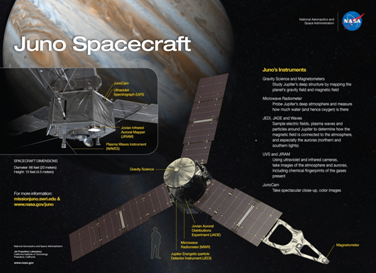Juno spacecraft followed by The Galileo is a key mission endeavoured to explore and study the biggest planet of the solar system “The Jupiter”. It was launched on 2011 from Cape Canaveral station, Florida. This craft is designed in a special way to study the
- composition,
- gravity field,
- magnetic field, and
- polar magnetosphere of Jupiter.

- The planet Jupiter was formed from by an enormous gas cloud 4.5bn years ago under the feeble light of the newborn Sun. The material leftover became the rest of the planets, the asteroids and the comets. All would fit easily within the bulk of Jupiter, a planet 11 times wider than Earth and 300 times more massive.
- This Juno spacecraft is designed with Solar Arrays instead of radioisotope thermoelectric generators, which were being used in ordinary outer orbit missions.
As per the design and plan on July 5th 2016, the spacecraft casted out the planet’s vast gravity and placed it onto the outward leg of its orbit. - The spacecraft surpassing through intense barrages of radiation and reaching 130,000 miles per hour as it passed 2,900 miles above Jupiter’s cloud tops.
- The critical and tedious manoeuvring of this spacecraft has been carried out in the NASA’s Jet Propulsion Laboratory.
- “Juno – Welcome to Jupiter”, acclaimed all the scientists and researchers in the station in immense joy and pleasure
AffairsCloud Recommends Oliveboard Mock Test
AffairsCloud Ebook - Support Us to Grow
Govt Jobs by Category
Bank Jobs Notification




